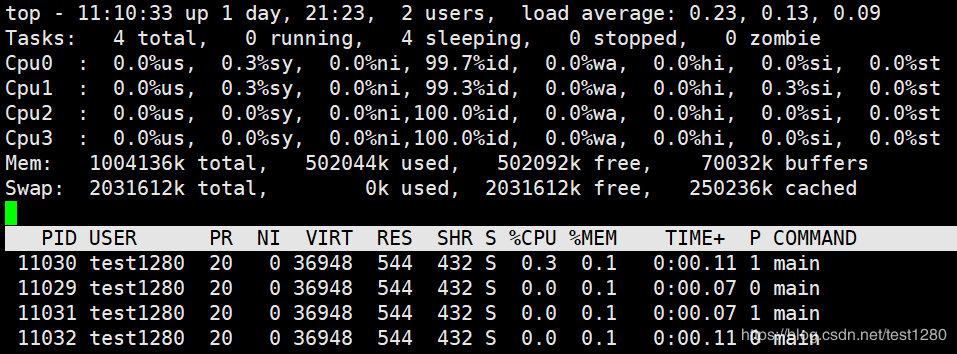在 Linux C/C++ 中通常是通過 pthread 庫進行線程級別的操作。
在 pthread 庫中有函數:
pthread_t pthread_self(void);
它返回一個 pthread_t 類型的變量,指代的是調用 pthread_self 函數的線程的 “ID”。
怎么理解這個“ID”呢?
這個“ID”是 pthread 庫給每個線程定義的進程內唯一標識,是 pthread 庫維持的。
由于每個進程有自己獨立的內存空間,故此“ID”的作用域是進程級而非系統級(內核不認識)。
其實 pthread 庫也是通過內核提供的系統調用(例如clone)來創建線程的,而內核會為每個線程創建系統全局唯一的“ID”來唯一標識這個線程。
這個系統全局唯一的“ID”叫做線程PID(進程ID),或叫做TID(線程ID),也有叫做LWP(輕量級進程=線程)的。
如何查看線程在內核的系統全局唯一“ID”呢?大體分為以下幾種方式。
測試代碼:
main.c
#define _GNU_SOURCE
#include <stdio.h>
#include <stdlib.h>
#include <string.h>
#include <unistd.h>
#include <pthread.h>
void *start_routine(void *arg) {
char msg[32] = "";
snprintf(msg, sizeof(msg)-1, "thd%d: i am thd%d\n", *((int *)arg), *((int *)arg));
while (1) {
write(1, msg, strlen(msg));
sleep(1);
}
}
int main() {
int th1 = 1;
pthread_t tid1;
pthread_create(&tid1, NULL, start_routine, &th1);
int th2 = 2;
pthread_t tid2;
pthread_create(&tid2, NULL, start_routine, &th2);
int th3 = 3;
pthread_t tid3;
pthread_create(&tid3, NULL, start_routine, &th3);
const char *msg = "main: i am main\n";
while (1) {
write(1, msg, strlen(msg));
sleep(1);
}
return 0;
}
在主線程中通過 pthread 庫創建三個線程,不斷輸出 “i am xxx” 的信息。
運行輸出:
[test1280@localhost 20190227]$ gcc -o main main.c -lpthread
[test1280@localhost 20190227]$ ./main
main: i am main
thd2: i am thd2
thd3: i am thd3
thd1: i am thd1
thd2: i am thd2
……
方法一:ps -Lf $pid
[test1280@localhost ~]$ ps -Lf 11029
UID PID PPID LWP C NLWP STIME TTY STAT TIME CMD
test1280 11029 9374 11029 0 4 10:58 pts/0 Sl+ 0:00 ./main
test1280 11029 9374 11030 0 4 10:58 pts/0 Sl+ 0:00 ./main
test1280 11029 9374 11031 0 4 10:58 pts/0 Sl+ 0:00 ./main
test1280 11029 9374 11032 0 4 10:58 pts/0 Sl+ 0:00 ./main
11209是待觀察的進程的PID。
輸出中可見此進程包含4個線程,他們的PID都是11209,PPID都是9374,其中LWP即我們要找的線程ID。
我們注意到有一個線程的LWP同進程的PID一致,那個線程就是主線程。
-L Show threads, possibly with LWP and NLWP columns
-f does full-format listing.
方法二:pstree -p $pid
[test1280@localhost ~]$ pstree -p 11029
main(11029)─┬─{main}(11030)
├─{main}(11031)
└─{main}(11032)
方法三:top -Hp $pid
[test1280@localhost ~]$ top -Hp 11029

在top中指定了進程PID,輸出包含四個線程,通過PID字段可獲知每個線程的PID(TID/LWP)。
man top
-H:Threads toggle
Starts top with the last remembered 'H' state reversed.
When this toggle is On, all individual threads will be displayed.
Otherwise, top displays a summation of all threads in a process.
-p:Monitor PIDs
方法四:ls -l /proc/$pid/task/
[test1280@localhost ~]$ ls -l /proc/11029/task/
total 0
dr-xr-xr-x. 6 test1280 test1280 0 Feb 27 10:58 11029
dr-xr-xr-x. 6 test1280 test1280 0 Feb 27 10:58 11030
dr-xr-xr-x. 6 test1280 test1280 0 Feb 27 10:58 11031
dr-xr-xr-x. 6 test1280 test1280 0 Feb 27 10:58 11032
方法五:pidstat -t -p $pid
[test1280@localhost ~]$ pidstat -t -p 11029
Linux 2.6.32-642.el6.x86_64 (localhost.localdomain) 02/27/2019 _x86_64_ (4 CPU)
11:20:39 AM TGID TID %usr %system %guest %CPU CPU Command
11:20:39 AM 11029 - 0.00 0.00 0.00 0.00 1 main
11:20:39 AM - 11029 0.00 0.00 0.00 0.00 1 |__main
11:20:39 AM - 11030 0.00 0.00 0.00 0.00 1 |__main
11:20:39 AM - 11031 0.00 0.00 0.00 0.00 0 |__main
11:20:39 AM - 11032 0.00 0.00 0.00 0.00 3 |__main
TGID是線程組ID,主線程的TID等同于主線程的線程組ID等同于主線程所在進程的進程ID。
man pidstat
-t Also display statistics for threads associated with selected tasks.
This option adds the following values to the reports:
TGID:The identification number of the thread group leader.
TID:The identification number of the thread being monitored.
方法六:源碼級獲取
main.c
#define _GNU_SOURCE
#include <stdio.h>
#include <stdlib.h>
#include <string.h>
#include <unistd.h>
#include <pthread.h>
#include <sys/types.h>
#include <sys/syscall.h>
pid_t gettid() {
return syscall(SYS_gettid);
}
void *start_routine(void *arg) {
pid_t pid = gettid();
pthread_t tid = pthread_self();
printf("thd%d: pid=%d, tid=%lu\n", *((int *)arg), pid, tid);
char msg[32] = "";
snprintf(msg, sizeof(msg)-1, "thd%d: i am thd%d\n", *((int *)arg), *((int *)arg));
while (1) {
write(1, msg, strlen(msg));
sleep(1);
}
}
int main() {
pid_t pid = gettid();
pthread_t tid = pthread_self();
printf("main: pid=%d, tid=%lu\n", pid, tid);
int th1 = 1;
pthread_t tid1;
pthread_create(&tid1, NULL, start_routine, &th1);
int th2 = 2;
pthread_t tid2;
pthread_create(&tid2, NULL, start_routine, &th2);
int th3 = 3;
pthread_t tid3;
pthread_create(&tid3, NULL, start_routine, &th3);
const char *msg = "main: i am main\n";
while (1) {
write(1, msg, strlen(msg));
sleep(1);
}
return 0;
}
syscall(SYS_gettid) 系統調用返回一個 pid_t 類型值,即線程在內核中的ID。
[test1280@localhost 20190227]$ gcc -o main main.c -lpthread
[test1280@localhost 20190227]$ ./main
main: pid=11278, tid=140429854775040
main: i am main
thd3: pid=11281, tid=140429833787136
thd3: i am thd3
thd2: pid=11280, tid=140429844276992
thd2: i am thd2
thd1: pid=11279, tid=140429854766848
thd1: i am thd1
……
線程的PID(TID、LWP)有什么價值?
很多命令參數的 PID 實際指代內核中線程的ID,例如 taskset、strace 等命令。
例如 taskset 命令,可以將進程綁定到某個指定的CPU核心上。
如果進程是多線程模式,直接使用 taskset 將僅僅把主線程綁定,其他線程無法被綁定生效。
example:
# 將 11282 進程綁定到CPU第0核心
[test1280@localhost ~]$ ps -Lf 11282
UID PID PPID LWP C NLWP STIME TTY STAT TIME CMD
test1280 11282 9374 11282 0 4 11:33 pts/0 Sl+ 0:00 ./main
test1280 11282 9374 11283 0 4 11:33 pts/0 Sl+ 0:00 ./main
test1280 11282 9374 11284 0 4 11:33 pts/0 Sl+ 0:00 ./main
test1280 11282 9374 11285 0 4 11:33 pts/0 Sl+ 0:00 ./main
[test1280@localhost ~]$ taskset -pc 0 11282
pid 11282's current affinity list: 0-3
pid 11282's new affinity list: 0
# 查看其他線程是否真的綁定到CPU第0核心
[test1280@localhost ~]$ taskset -pc 11283
pid 11283's current affinity list: 0-3
[test1280@localhost ~]$ taskset -pc 11284
pid 11284's current affinity list: 0-3
[test1280@localhost ~]$ taskset -pc 11285
pid 11285's current affinity list: 0-3
[test1280@localhost ~]$ taskset -pc 11282
pid 11282's current affinity list: 0
# 此時實際只綁定主線程到CPU第0核心
# 將其他四個線程一并綁定到CPU第0核心
[test1280@localhost ~]$ taskset -pc 0 11283
pid 11283's current affinity list: 0-3
pid 11283's new affinity list: 0
[test1280@localhost ~]$ taskset -pc 0 11284
pid 11284's current affinity list: 0-3
pid 11284's new affinity list: 0
[test1280@localhost ~]$ taskset -pc 0 11285
pid 11285's current affinity list: 0-3
pid 11285's new affinity list: 0
# 此時,進程PID=11282的進程所有線程都將僅在CPU第0核心中運行
strace 同理,可以指定線程PID,追蹤某個線程執行的系統調用以及信號。
到此這篇關于詳解Linux獲取線程的PID(TID、LWP)的幾種方式的文章就介紹到這了,更多相關Linux獲取線程的PID內容請搜索腳本之家以前的文章或繼續瀏覽下面的相關文章希望大家以后多多支持腳本之家!